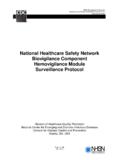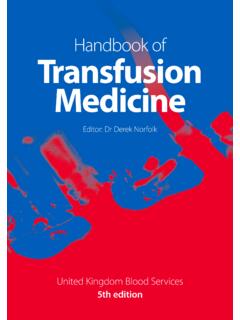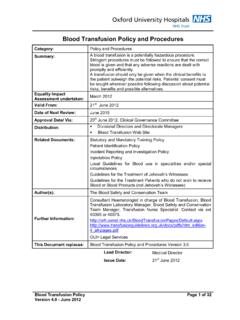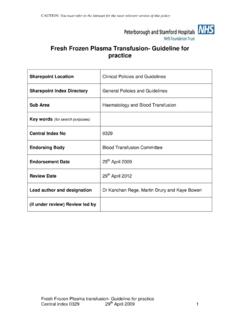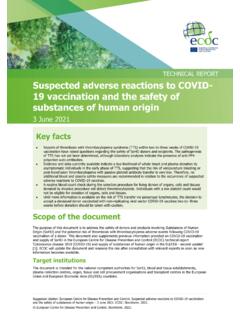Transcription of Red Blood Cell Transfusion - Hematology.org
1 Robert Weinstein, MDUniversity of Massachusetts Medical SchoolNovember 2016 Adapted from Red Blood Cell Transfusion : A clinical practice guideline from the AABB, Clinical Practice Guidelines from the AABB: Red Blood cell Transfusion thresholds and storage, and additional sourcesRed Blood CellTransfusionA Pocket Guide for the ClinicianRed Blood Cells as a Therapeutic ProductAppropriate uses of red Blood cell (RBC) Transfusion Treatment of symptomatic anemia Prophylaxis in life-threatening anemia Restoration of oxygen-carrying capacity in case of hemorrhage RBCs are also indicated for exchange Transfusion w Sickle cell disease w Severe parasitic infection (malaria, babesiosis)
2 W Severe methemoglobinemia w Severe hyperbilirubinemia of newbornRBC Transfusion is not routinely indicated for pharmacologically treatable anemia such as: Iron deficiency anemia Vitamin B12 or folate deficiency anemiaDosage and administration One unit of RBC will raise the hemoglobin of an average-size adult by ~1 g/dL (or raise HCT ~3%) ABO group of RBC products must be compatible with ABO group of recipient RBC product must be serologically compatible with the recipient (see Pretransfusion Testing). Exceptions can be made in emergencies (see Emergency Release of Blood Products). Rate of Transfusion w Transfuse slowly for first 15 minutes w Complete Transfusion within 4 hours (per FDA)Major Red Cell Products for TransfusionMost RBC products are derived by collection of 450-500 ( 10%) mL of whole Blood from volunteer donors and removal of the plasma by centrifugation (see Table 1).
3 After removal of the plasma, the resulting product is red Blood cells (referred to informally as packed red Blood cells ).The most commonly available US RBC product has a 42-day Blood bank shelf life and HCT 55-65%.Table 1. Special Processing of RBC for TransfusionProcessIndicationsTechnical ConsiderationsLeukocyte ReductionDecrease risk of recurrent febrile, nonhemolytic Transfusion reactionsDecrease risk of cytomegalovirus (CMV) transmission (marrow transplant)Decrease risk of HLA-alloimmunizationDoes not prevent Transfusion -associated graft-versus-host disease (TA-GVHD)Most commonly achieved by filtrationUsually soon after collection (prestorage)May be performed at bedside<5x106 leukocytes per product (per FDA)Washing (removes residual plasma)
4 Decrease risk of anaphylaxis in IgA-deficient patient with anti-IgA antibodiesDecrease reactions in patients with history of recurrent, severe allergic or anaphylactoid reactions to Blood product transfusionWash fluid is NaCl dextroseShelf life of washed RBCs24 hours at 1-6 C4 hours at 20-24 CMay lose 20% of red cells in washing processIrradiationPrevention of TA-GVHD in certain circumstancesDonor categoriesProduct donated by family memberProduct from HLA-selected donorProducts from directed donors whose relationship to recipient s family has not been establishedPediatric practiceIntrauterine Transfusion (IUT)Exchange or simple Transfusion in neonates if prior IUTC ongenital immune deficiency statesAcute leukemia.
5 HLA-matched or family-donated productsAllogeneic hemopoietic progenitor cell (HPC) transplant recipientAllogeneic HPC donor 7 days prior to, or during, HPC harvestAutologous HPC recipientHodgkin diseaseHistory of treatment with purine analogues and related drugsFludarabine2 CDA (Cladribine )Deoxycoformycin (Pentostatin )Clofarabine (Clolar )Bendamustine (Treanda )Nelarabine (Arranon )History of treatment with alemtuzumab (anti-CD52)Aplastic anemia on rabbit anti-thymocyte globulinRadiation dose: 2500 cGy to center of productGamma or X-irradiationShelf life of irradiated product: up to 28 days unless original expiration date is soonerNB: Supernatant K+ may be higher than usualAllogeneic HPC transplant recipient.
6 Start with initiation of conditioning regimenContinue throughout period of GVHD prophylaxisUsually for at least 6 monthsUntil lymphocytes are > 1 x 109/LIndefinitely if treated for chronic GVHDA utologous HPC recipient7 days prior to, and during, harvestInitiation of conditioning through 3 months post transplant (6 months if TBI was used)Pretransfusion TestingPrevents incompatible red cell Transfusion Compatibility of donor red cells and recipient plasma Avoid immune hemolytic Transfusion reactions in the recipientPretransfusion Blood sample from the intended recipient Usually EDTA tube (plasma and red cells)
7 Proper labeling of the sample w 2 independent patient identifiers w Identity of the phlebotomist w Date and time of sample collection w Sample rejected without these Age of the sample w Up to 3 days if hospital inpatient or, in past 3 months, recipient - Has been pregnant - Has been transfused - Has uncertain history of either w Longer (often 1 2 weeks, according to hospital policy) for outpatient pre-op testing if negative history within 3 monthsTable 2. Pretransfusion TestingTestPurposeReagentsTimeABO Group & Rh TypeDetermine if recipient s Blood group Rho(D) is positive or negativeTest recipient s red cells with anti-A, anti-B, anti-D.
8 Test recipient s plasma with A1* and B cells~25 minAntibody ScreenDetect unexpected, clinically significant (non-ABO) anti-RBC antibodies in recipient s plasmaTest recipient s plasma with phenotyped reagent RBCs~50 minAntibody IdentificationIdentify specificity of anti-RBC antibody if antibody screen is posTest recipient s plasma with many reagent RBCsVaries: Hours to daysImmediate Spin Crossmatch (when antibody screen is negative)Ensure ABO compatibility between recipient s plasma and RBC product chosen for Transfusion Test recipient s plasma with sample of red cells from product chosen for Transfusion ~10 minFull Serological Crossmatch (when antibody screen is positive)Ensure full serological compatibility between recipient s plasma and RBC product chosen for transfusionTest recipient s plasma with sample of red cells from product chosen for Transfusion .
9 Includes extra incubations ( at 37 C and with Coombs reagent).Up to an hourElectronic Crossmatch(not universally available)Match ABO/Rh compatible RBC from inventory with patient whose ABO/Rh status has been confirmed and who has no history of, and negative testing for, RBC alloantibodies Validated Blood bank computer system.~10-15 min*A1 is the most common subgroup of Group AEmergency Release of Blood ProductsAn emergency release of Blood products is warranted when the clinical setting precludes waiting for completion of pretransfusion and compatibility testing. Examples include: Severe, ongoing life-threatening hemorrhage Life-threatening anemiaWhat you should do: Notify Blood bank of need for emergency release of RBCs Complete hospital s emergency release form w Documents your declaration of a Transfusion emergency w federal regulations require 2 specific items on the form - Statement of the nature of the emergency ( massive GI hemorrhage ) - Signature of MD or equivalent ; (PA, NP, RN, etc.)
10 Cannot sign) Send patient Blood sample to Blood bank ASAP (before emergency Transfusion begins, if possible)What you ll get from the Blood bank (depending on how much testing has already been performed): Uncrossmatched RBCs (ABO group-specific if determined on a current Blood specimen) Group O RBCs if Blood bank has not documented patient s ABO group on a fresh Blood sample w Rh neg depending on availability and hospital policy, if patient s Rh status is unknownBlood bank will retrospectively crossmatch all emergently issued units when it receives the patient s testing sampleBlood bank will begin issuing type specific and crossmatched products when testing is completeTransfusion of Incompatible RBCsClinical scenario.





